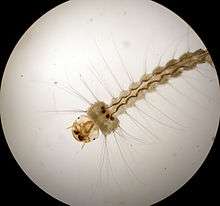Wyeomyia smithii
| Wyeomyia smithii | |
|---|---|
 | |
| Wyeomyia smithii larva magnified 40× | |
| Scientific classification | |
| Kingdom: | Animalia |
| Phylum: | Arthropoda |
| Class: | Insecta |
| Order: | Diptera |
| Family: | Culicidae |
| Subfamily: | Culicinae |
| Tribe: | Sabethini |
| Genus: | Wyeomyia |
| Species: | W. smithii |
| Binomial name | |
| Wyeomyia smithii Coquillett, 1901 | |
Wyeomyia smithii, the pitcher plant mosquito, is an inquiline mosquito that breeds only in the phytotelma — that is, the water contained by the purple pitcher plant, Sarracenia purpurea. In this microcommunity of bacteria, rotifers, protozoa, and midges, W. smithii is the top-level predator; its presence determines the bacterial species diversity within the pitcher.[1] It is not in any way a pest mosquito, neither biting nor approaching humans or livestock, although there are some populations in the southern US, such as that in the Apalachicola National Forest, that have been observed to take blood meals after laying an initial egg batch,[2]
Wyeomyia smithii is a model organism for the study of photoperiodism, the biotic process of controlling seasonal life history events by measuring day length as a reliable predictor of the seasons. W. smithii enters a state of developmental arrest, larval diapause, that is initiated and maintained by short day lengths and averted or terminated by long day lengths.[3] Because of global warming and shortening of winters, W. smithii has been observed now to require shorter days in order to go dormant. This led to thinking that a microevolutionary selection is happening: mosquitoes that waited more to go dormant and which had a greater fitness have been more selected.[4]
References
- ↑ Celeste N. Peterson, Stephanie Day, Benjamin E. Wolfe, Aaron M. Ellison, Roberto Kolter & Anne Pringle (2008). "A keystone predator controls bacterial diversity in the pitcher-plant (Sarracenia purpurea) microecosystem" (PDF). Environmental Microbiology. 10 (9): 2257–2266. doi:10.1111/j.1462-2920.2008.01648.x. PMID 18479443.
- ↑ W.E. Bradshaw, Blood-feeding and Capacity for Increase in the Pitcher-plant Mosquito, Wyeomyia smithii
- ↑ William E. Bradshaw & L. Philip Lounibos (1977). "Evolution of dormancy and its photoperiodic control in pitcher-plant mosquitoes". Evolution. 31 (3): 546–567. doi:10.2307/2407521. JSTOR 2407521.
- ↑ "Evolution 101: Examples of Microevolution". University of California Berkeley. Retrieved 2014-10-15.